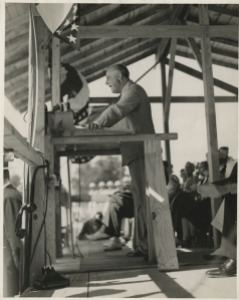1936 Podium (M.O. 2007.125)

This aluminum and steel podium was specially designed for use by FDR during a 1936 presidential campaign stop at the new Municipal Auditorium in Kansas City, Missouri—an immense structure built with funds from the New Deal’s Public Works Administration (PWA). A plaque inside the podium reads, “Presented by the citizens of Kansas City, Missouri/ to the honorable/ Franklin Delano Roosevelt/ President of the United States of America/ on the occasion of his dedication/ of the new Municipal Auditorium/ October 13, 1936/ H.F. McElroy, city manager.” Following the President’s speech the podium was shipped to the White House. It was later transferred to the National Archives and Records Administration.
With considerable physical effort, using specially designed podiums such as this one, FDR was able to deliver his speeches from a standing position while supporting himself with his arms. Wearing leg braces, the President would approach a podium like this one with the aid of a cane and the strong arm of a companion. They supported his weight while he pitched his body forward. He then placed his hands on the arm rails at the back of the podium and, using his arms to hold his weight, moved himself forward the last few steps.
Though it appears to be an ordinary podium from the front, this one has thigh-high extensions in the back, providing the necessary stability to support the President’s weight. The podium’s six feet could be bolted to the floor to add further support. With its raised panels and modern materials, this podium is particularly attractive and well-built, in keeping with its intended use at the dedication of a newly minted building. It includes two handsome presidential seals on the front. Other podiums FDR used were more utilitarian in design and materials (see photo below). But all served to allow the President to stand while delivering his speeches.

FDR’s stop at the new Kansas City auditorium was part of a ten-day campaign tour that began on Thursday, October 8, 1936 when he, Eleanor, and a delegation of family and close political associates left Hyde Park by train. During this tour the President visited eleven states. Traveling by train, he made speaking stops in Illinois, Minnesota, Iowa, Nebraska, Wyoming, Colorado, Kansas, Missouri, Michigan, Ohio, and New York before returning to Hyde Park on October 17.
The Kansas City stop on October 13 was the fifth of six train stops on that date. Roosevelt’s day began with a speech in Wichita, Kansas. Next he gave three “rear-platform remarks” from the back of his train in Florence, Emporia, and Olathe, Kansas. After his speech at the auditorium in Kansas City he returned to the campaign train and gave one last talk from back of the train in Carrollton, Missouri.

In Kansas City, FDR spoke to a packed house, including a large group of young people seated in the front rows. He directed his remarks toward this new generation, who were growing up during very difficult economic times:
“As we take stock, we recognize that the most priceless of our human assets are the young men and women of America–the raw material out of which the United States must shape its future.… And so, the highest duty of any Government is to order public affairs so that opportunities for youth shall be made ever broader and firmer.”
FDR touted his administration’s investment in institutions that served youth, especially schools. “The school,” he noted, “is the last expenditure upon which America should be willing to economize.” He also extolled New Deal initiatives like the Civilian Conservation Corps (CCC) and the National Youth Administration (NYA) which were helping young people find direction, work, and education and giving them hope for the future.

Art Moderne/ Decco style and was hailed at the time as an
architectural triumph. Today the beautifully preserved and
maintained building is a city landmark, hosting sports events,
musical acts and other cultural events.

You must be logged in to post a comment.